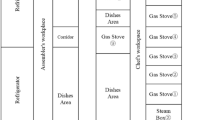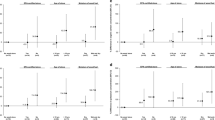Abstract
Background
Meat grilled with wood charcoal is the most popular meal in Central Asia, but little is known about the grillers’ occupational exposure to fine particulate matter (PM) in fumes.
Objectives
The aim of this study was to provide a quantitative analysis of occupational exposure to fine PM in grillers in the workplace.
Methods
We assessed exposure to PM2.5 from barbecue fumes using SidePak AM520 in six popular cafes in Almaty, Kazakhstan. Grillers wore devices for 8 h of work shift for 7 days in each place. Within- and between-place variances of PM2.5 mass concentrations were calculated using analysis of variance, and we also calculated the fold range of the 95% variance within (wR0.95) and between places (bR0.95), as well as exceedance (γ) and the probability of overexposure (θ).
Results
Two modes of exposure were identified, including intermittent and continuous. The median of daily geometric mean PM2.5 concentrations was 0.143 (interquartile range (IQR): 0.213) and 0.404 (IQR: 0.243) mg/m3, accordingly. bR0.95 was very large (20.2), but wR0.95 was even greater (47.8), illustrating extremely high fluctuations in PM2.5 concentrations; γ was 0.116, and θ was 0.095.
Significance
Very high occupational exposure to barbecue fumes in grillers is overlooked and likely causes elevated health risks.
This is a preview of subscription content, access via your institution
Access options
Subscribe to this journal
Receive 6 print issues and online access
$259.00 per year
only $43.17 per issue
Buy this article
- Purchase on Springer Link
- Instant access to full article PDF
Prices may be subject to local taxes which are calculated during checkout



Similar content being viewed by others
References
Wu C-C, Bao L-J, Guo Y, Li S-M, Zeng EY. Barbecue fumes: an overlooked source of health hazards in outdoor settings? Environ Sci Technol. 2015;49:10607–15.
Lao J-Y, Wu C-C, Bao L-J, Liu L-Y, Shi L, Zeng EY. Size distribution and clothing-air partitioning of polycyclic aromatic hydrocarbons generated by barbecue. Sci Total Environ. 2018;639:1283–9.
Kabir E, Kim K-H, Ahn J-W, Hong O-F, Sohn JR. Barbecue charcoal combustion as a potential source of aromatic volatile organic compounds and carbonyls. J Hazard Mater. 2010;174:492–9.
Badyda AJ, Widziewicz K, Rogula-Kozłowska W, Majewski G, Jureczko I. Inhalation exposure to PM-bound polycyclic aromatic hydrocarbons released from barbecue grills powered by gas, lump charcoal, and charcoal briquettes. In: Pulmonary disorders and therapy. Springer: Cham; 2017. p. 11–27.
Kim KH, Jahan SA, Kabir E, Brown RJC. A review of airborne polycyclic aromatic hydrocarbons (PAHs) and their human health effects. Environ Int. 2013;60:71–80.
Vinnikov D, Raushanova A, Kyzayeva A, Romanova Z, Tulekov Z, Kenessary D, et al. Lifetime occupational history, respiratory symptoms and chronic obstructive pulmonary disease: results from a population-based study. Int J Chron Obstruct Pulmon Dis. 2019;14:3025.
Vinnikov D, Tulekov Z, Raushanova A. Occupational exposure to particulate matter from air pollution in the outdoor workplaces in Almaty during the cold season. PLoS ONE. 2020;15:e0227447.
Rappaport SM, Kupper LL. Quantitative exposure assessment. California, USA: El Cerrito; 2008.
Rappaport SM. Assessment of long-term exposures to toxic substances in air. Ann Occup Hyg. 1991;35:61–121.
Blanc PD, Annesi-Maesano I, Balmes JR, Cummings KJ, Fishwick D, Miedinger D, et al. The occupational burden of nonmalignant respiratory diseases. An Official American Thoracic Society and European Respiratory Society Statement. Am J Respir Crit Care Med. 2019;199:1312–34.
Yang H, Li S, Sun L, Zhang X, Cao Z, Xu C, et al. Smog and risk of overall and type-specific cardiovascular diseases: a pooled analysis of 53 cohort studies with 21.09 million participants. Environ Res. 2019;172:375–83.
Shah ASV, Langrish JP, Nair H, McAllister DA, Hunter AL, Donaldson K, et al. Global association of air pollution and heart failure: a systematic review and meta-analysis. Lancet. 2013;382:1039–48.
Atkinson RW, Kang S, Anderson HR, Mills IC, Walton HA. Epidemiological time series studies of PM2.5 and daily mortality and hospital admissions: a systematic review and meta-analysis. Thorax. 2014;69:660–5.
Li M-H, Fan L-C, Mao B, Yang J-W, Choi AMK, Cao W-J, et al. Short-term exposure to ambient fine particulate matter increases hospitalizations and mortality in COPD: a systematic review and meta-analysis. Chest. 2016;149:447–58.
Madani IM, Khalfan S, Khalfan H, Jidah J, Aladin MN. Occupational exposure to carbon monoxide during charcoal meat grilling. Sci Total Environ. 1992;114:141–7.
Bede-Ojimadu O, Orisakwe OE. Exposure to wood smoke and associated health effects in Sub-Saharan Africa: a systematic review. Ann Glob Health. 2020;86:32.
Acknowledgements
We would like to thank all grillers for their participation, as well as cafe management and the Dean of the Faculty of Medicine and Healthcare, Zhanna Kalmatayeva, for their support.
Funding
The publication was prepared with the support of the “RUDN University Program 5-100.”
Author information
Authors and Affiliations
Corresponding author
Ethics declarations
Conflict of interest
The authors declare that they have no conflict of interest.
Additional information
Publisher’s note Springer Nature remains neutral with regard to jurisdictional claims in published maps and institutional affiliations.
Rights and permissions
About this article
Cite this article
Vinnikov, D., Romanova, Z. & Zhumabayeva, G. Air pollution in the workplace: making shish kebab is an overlooked occupational hazard. J Expo Sci Environ Epidemiol 31, 777–783 (2021). https://doi.org/10.1038/s41370-020-00283-4
Received:
Revised:
Accepted:
Published:
Issue Date:
DOI: https://doi.org/10.1038/s41370-020-00283-4



